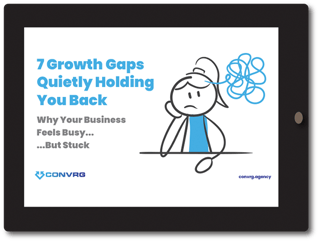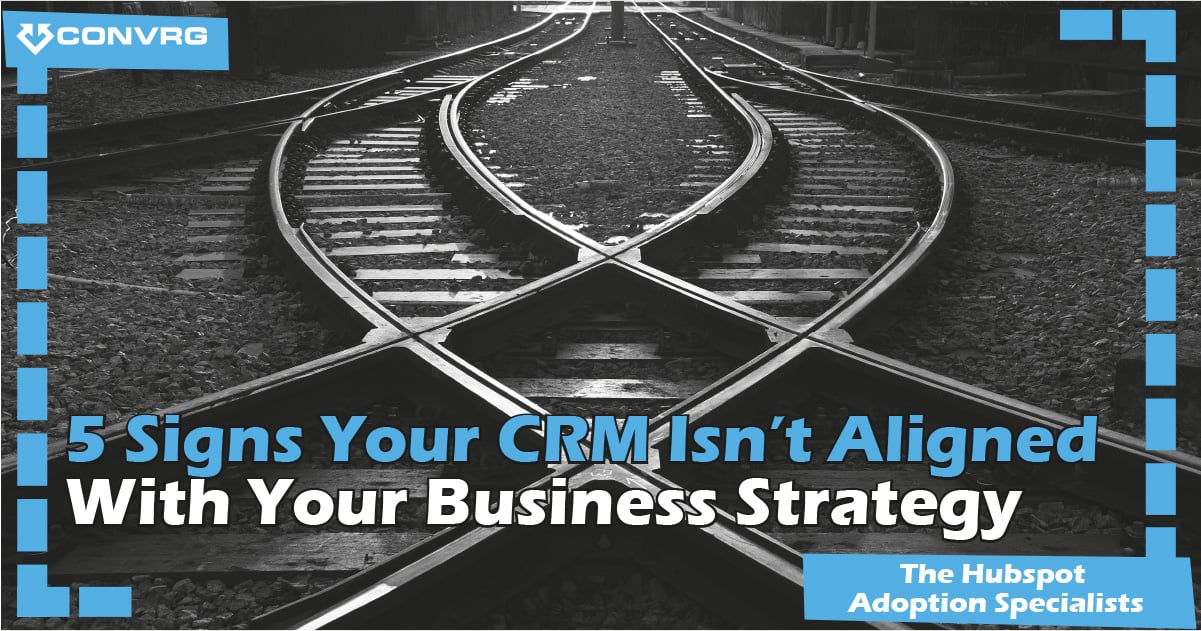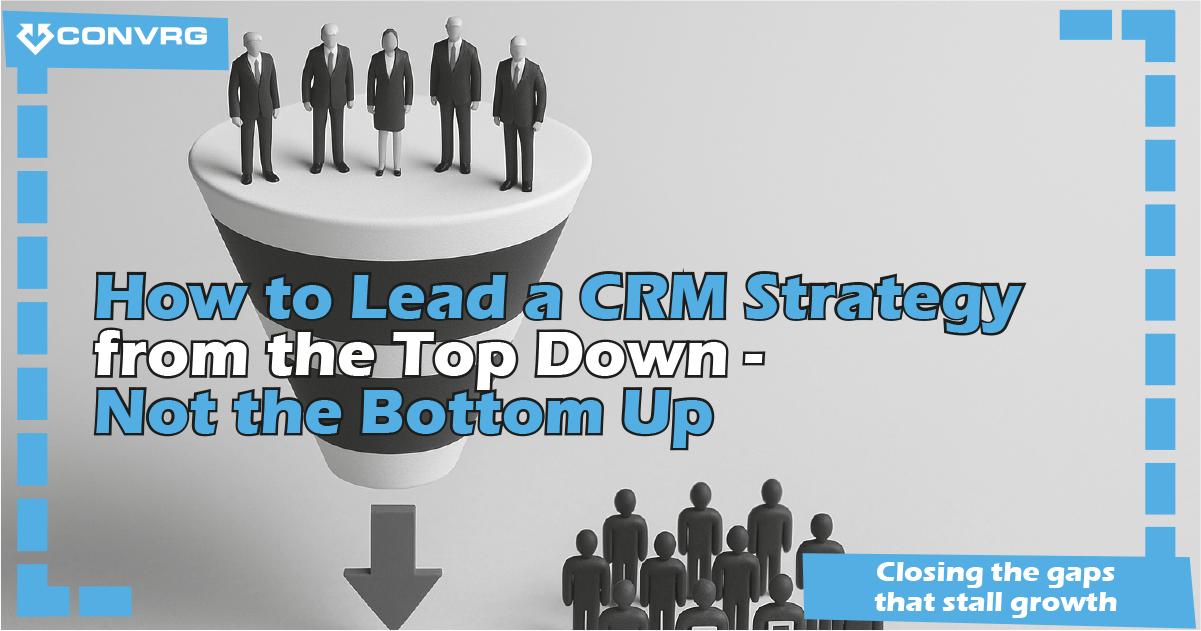A Quick Story: Bridgend College’s Wake-Up Call
When Bridgend College implemented HubSpot, their goals were ambitious: streamline operations, reduce marketing spend, and improve lead generation efficiency.
But within months, something started to feel off.
The system was live. The tools were working. The training had been delivered.
So why wasn’t adoption sticking?
The answer came down to something we see far too often in scaling organisations: CRM was treated like a system rollout, not a strategic shift.
Leadership weren’t aligned. Priorities were competing. Teams were overwhelmed from reduced headcount. And the CRM – once hailed as the growth engine – was now being bypassed, ignored, or underutilised.
“We’ve made the investment,” one senior leader said.
“But we’re not seeing the outcomes.”
That’s when Bridgend College brought in CONVRG.
We applied our SIMPLIFI Framework to realign leadership, reconnect processes, and rebuild confidence in the system.
By treating CRM as a business-critical layer of strategy, not just a sales and marketing tool, we helped them turn things around.
- Leadership re-engaged and took ownership
- Team workflows were restructured
- Automation targets were finally met
- And HubSpot became central to how the college operated – not just an optional extra
The turnaround didn’t happen because of a new integration or feature.
It happened because we addressed the real issue:
Their CRM strategy wasn’t actually a business strategy.
Why CRM Becomes a Sticking Point in Scaling Companies
In our experience with dozens of scaling B2B organisations, this pattern is common:
- The CRM system is purchased with good intentions
- The rollout starts strong
- And then… adoption stalls, metrics misalign, and frustration creeps in
What’s going wrong?
It’s not about the platform itself.
It’s about how that platform is positioned inside the business.
When CRM is treated as a standalone project – typically led by marketing, sales ops, or IT – it becomes disconnected from the strategic engine of the business.
What’s needed is a shift in mindset:
CRM isn’t just a tech implementation.
It’s your go-to-market strategy, systemised.
Symptoms of a CRM Strategy Misalignment
If any of these feel familiar, you’re not alone:
- Teams work in silos with disconnected goals
- Handovers between sales, marketing, and service feel clunky
- Leaders don’t trust the reports because “they don’t match what we see”
- The CRM doesn’t reflect the actual customer journey
- Forecasts are inaccurate, dashboards unused, and data is duplicated or outdated
These are symptoms of a CRM operating in isolation – or worse, becoming a blocker rather than an enabler.
When the CRM strategy isn’t aligned with the business model, leadership goals, and execution rhythm, it stops scaling.
CRM Isn’t a Department – It’s the Digital Layer of the Business
We like to say this at CONVRG:
“Your CRM should be your business – reflected in software.”
It should:
- Mirror your customer journey
- Reinforce your team structures and handovers
- Provide real-time insight into what’s working (and what’s not)
- Be the source of truth your leadership team trusts when making decisions
But too often, it ends up being:
- A glorified email platform
- A sales admin system
- A reporting tool that no one opens
- Or worse – a tool that’s quietly ignored
The Cost of Misalignment (That You Can’t See on the Balance Sheet)
Here’s what misalignment quietly costs you:
|
Misalignment |
Cost |
|
Leads passed without context |
Low conversion, wasted effort |
|
Manual workarounds |
Lost time, inconsistent processes |
|
Disjointed reporting |
Poor decisions, strategy drift |
|
Low adoption |
Reduced ROI on your CRM investment |
|
Leadership detachment |
No shared vision of success |
These aren’t just operational issues.
They’re strategic blockers.
Three Strategic Gaps We See Repeatedly
Through our SIMPLIFI engagements, we’ve identified three core strategic gaps that sit beneath most CRM frustrations:
- The Leadership Gap
No one in the leadership team owns CRM as a business-critical function.
Departments pursue their own goals, and CRM reflects this fragmentation.
There’s no top-down alignment or clarity on what “good” looks like.
- The Execution Gap
The business treats CRM as a system to install and train, rather than an evolving operating model.
That means:
- No ownership at the leadership level
- No change management or strategic oversight
- No regular retros or continuous improvement cycles
- The Data Gap
Metrics don’t match how success is measured at board level. Teams chase activity, not outcomes. And reporting becomes a game of guesswork.
Until these three gaps are addressed, no amount of features or integrations will fix CRM performance.
Why the COO (Not Just Marketing) Needs to Own CRM Strategy
In scaling firms, marketing often drives the CRM conversation.
But without leadership ownership – especially from operations – it stalls.
That’s because CRM isn’t about one function. It’s about the coordination of:
- Sales and marketing
- Customer service and success
- Commercial planning and revenue ops
- Data, reporting, and strategic decision-making
This needs operational thinking. Process design. Measurement discipline.
And a deep understanding of how people, systems, and goals interact.
CRM ownership belongs at the strategic table – not the sidelines.
A Strategy-Led CRM Approach in Action
Let’s look at the difference in outcomes when CRM is led tactically vs strategically:
|
Tool-Led CRM Rollout |
Strategy-Led CRM Execution |
|
|
Owner |
Marketing or IT |
Leadership team |
|
Focus |
Features & tools |
Business goals & outcomes |
|
Adoption |
Training & nudges |
Process redesign & ownership |
|
Success Metrics |
User logins, email sends |
Pipeline accuracy, revenue velocity, team efficiency |
|
Value |
Admin reduction |
Scalable growth engine |
At CONVRG, we’ve seen this play out time and again.
Companies that treat CRM as strategic infrastructure don’t just get adoption – they get acceleration.
The Most Common Misdiagnosis: “We Just Need Better Training”
One of the most common responses we see when CRM usage drops is this:
“Let’s run more training.”
It’s understandable. If people aren’t using the system correctly, they probably don’t understand it, right?
Sometimes, yes.
But more often than not, training is a surface-level fix for a structural issue.
What looks like a knowledge gap is usually a meaning gap. Teams aren’t sure:
- Why they’re being asked to use it
- How it connects to their actual goals
- Who’s really responsible for what
- Or what success is supposed to look like
If you haven’t addressed those upstream issues, no amount of training will stick.
This is where leadership makes the difference – not just in setting direction, but in aligning intent with system design and process flow.
For COOs: Your Role in Fixing (and Preventing) CRM Failure
If you’re in charge of operations, revenue, or growth, your fingerprints should be all over your CRM strategy.
Here’s what that looks like in practice:
- Lead a monthly CRM retro with department heads
- Audit your dashboards – can you actually make decisions from them?
- Review team workflows end-to-end
- Be the tie-breaker when alignment breaks down between sales, marketing, and CX
This isn’t about micromanaging the tech.
It’s about owning the system that enables your business model to scale.
What Bridgend Teaches Us
The most powerful part of the Bridgend story isn’t that we “fixed HubSpot.”
It’s that we helped the leadership team see CRM as a strategic enabler.
That mindset shift unlocked everything else.
- CRM became part of how the college ran reviews and tracked goals
- Leaders started asking better questions – and getting clearer answers
- The system earned trust, and the team started using it because it made their jobs easier
That’s the power of aligning CRM to business strategy.
It removes friction. Builds trust. Fuels growth.
What Happens Next Is Up to You
If you’ve made the investment in CRM but the results aren’t showing up – this is your chance to course correct.
Ask yourself:
Is our CRM a system we use?
Or is it the system that drives how we grow?
That’s the difference between busy and scalable.
Between short-term wins and sustainable momentum.
Still Guessing Where It’s Going Wrong?
Don’t.
Download our free guide:
The 7 Growth Gaps Quietly Holding You Back
It shows you exactly where to look when growth starts feeling like a grind.







